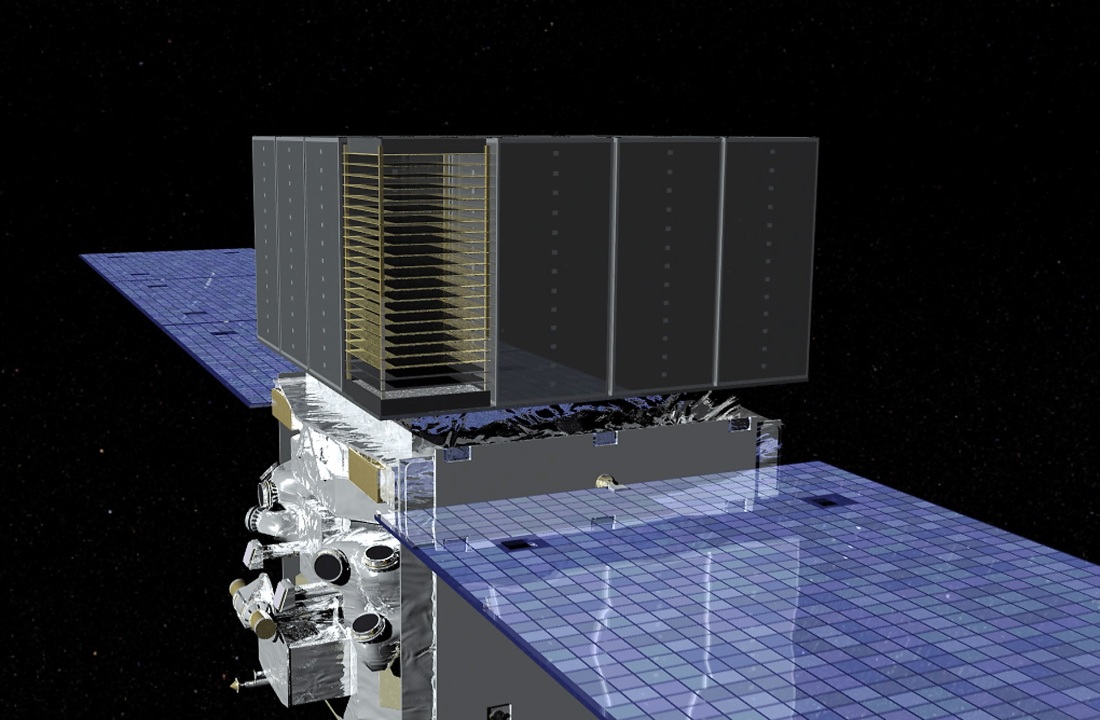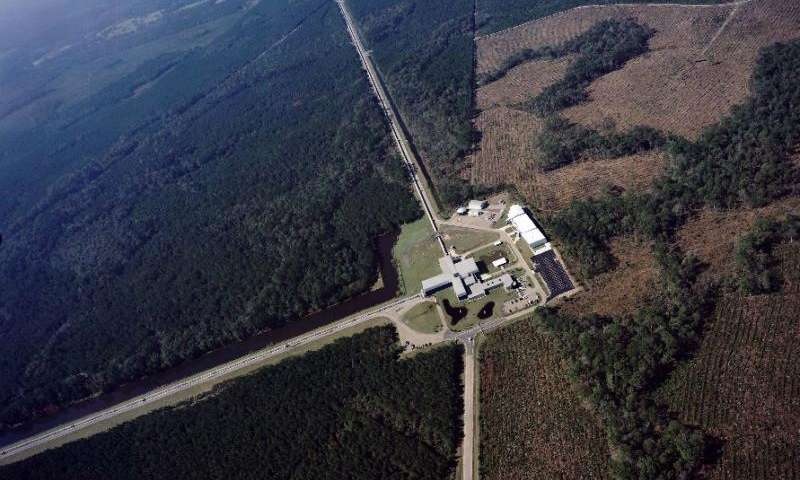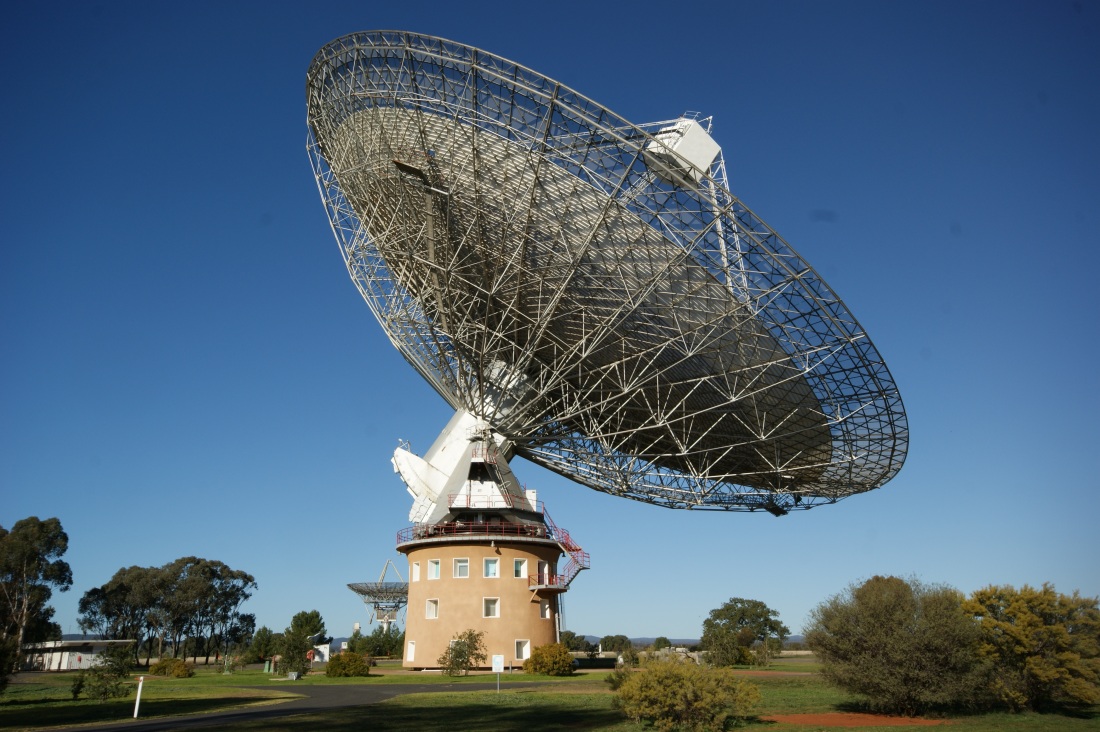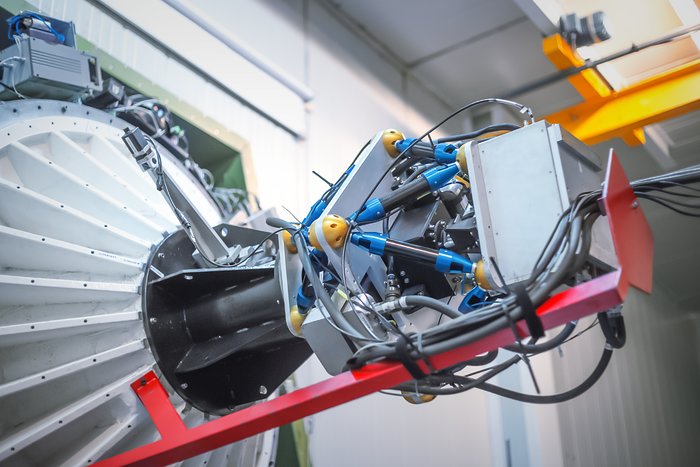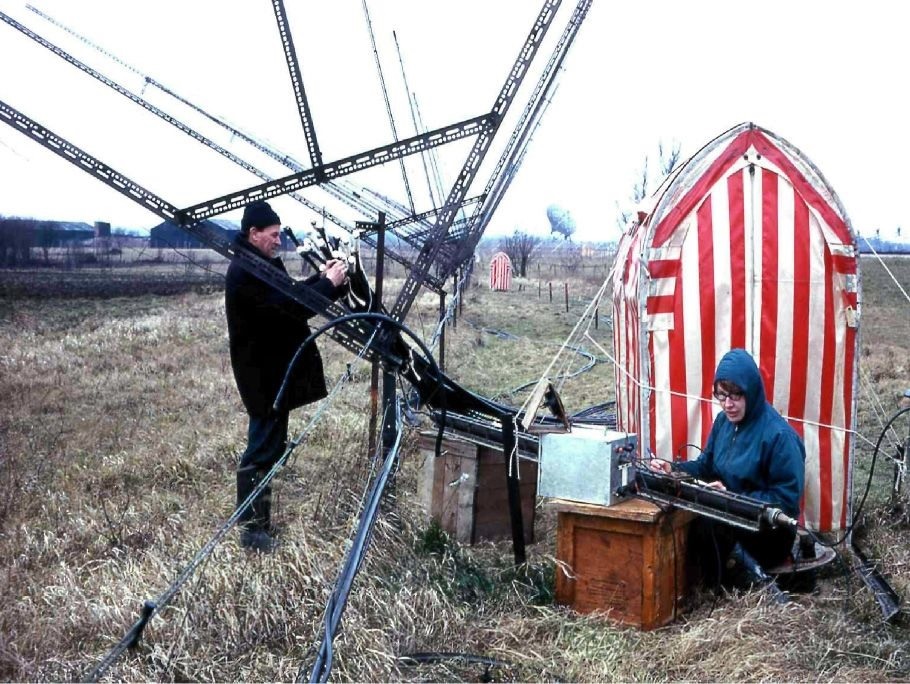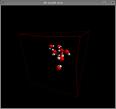
Einstein@home

After two decades and more than half a billion dollars, LIGO, the world’s largest gravitational-wave observatory, is on the verge of a detection. Maybe.
16 July 2014
Alexandra Witze
In the Louisiana swamps just east of Baton Rouge, the daily hunt for gravitational waves cannot really get started until well after noon.
Mornings are a lost cause, thanks to the sonic chaos from traffic rumbling along the nearby interstate highway, trains roaring past and loggers occasionally unleashing their chainsaws on plantations of pine trees.
Even now, at 6 p.m. on a weekday evening in May, Ryan de Rosa is gazing with resignation at a set of computer monitors in the control room of the Laser Interferometer Gravitational-Wave Observatory (LIGO). The displays are starting to stabilize, but they still show the myriad jolts — imperceptible to humans — that are rocking the ground. The traces, generated by distant earthquakes, traffic and even waves breaking on the coast of the Gulf of Mexico more than 100 kilometres away, look like jagged mountain peaks.
De Rosa, a physicist at Louisiana State University in Baton Rouge, knows he has a long night ahead of him. He and half a dozen other scientists and engineers are trying to achieve ‘full lock’ on a major upgrade to the detector — to gain complete control over the infrared laser beams that race up and down two 4-kilometre tunnels at the heart of the facility.

Technicians work on part of the LIGO gravitational-wave detector in Livingston, Louisiana.

Caltech LIGO Hanford
By precisely controlling the path of the lasers and measuring their journey in exquisite detail, the LIGO team hopes to observe the distinctive oscillations produced by a passing gravitational wave: a subtle ripple in space-time predicted nearly a century ago by Albert Einstein, but never observed directly.
Within weeks of this May evening, de Rosa and his colleagues will finally achieve full lock. A team working on an identical LIGO detector at the Hanford nuclear complex in Washington state should get there within months. If all goes well, the dual devices — which have together cost some US$620 million — could resume taking data next year. They will be the most sensitive of several gravitational-wave detectors around the world that are racing to be the first to claim a discovery.
The anticipation and competition are intense. Finding direct evidence of gravitational waves would launch a new era of astronomy. Spotting not just one gravitational-wave source, but eventually dozens and then thousands, astronomers say, will give them new ways to watch black holes collide, stars annihilate themselves and space-time shimmy. Gravitational waves would thus open an entirely new window onto a dynamic, ever-changing universe.
There is just one problem. The first incarnation of LIGO hunted the waves for nearly a decade — and found none. Now, with the major upgrade, the project faces the hard reality of having to finally deliver on its promises.
Everywhere and nowhere
In theory, Earth should be awash in gravitational waves. They are thought to come from any cosmic event that disturbs the fabric of space and time with sufficient force, in much the same way that seismic waves radiate from an earthquake. A dying star that explodes as a supernova should produce a tsunami of gravitational waves. More-rhythmic waves might come from the rotation of a dense object that is not quite perfectly symmetrical — say, a furiously spinning neutron star with a small bulge in its side. Another source might be a pair of black holes or neutron stars that whirl around one another, gradually drawing closer until they collide in a final, catastrophic merger.

Illustration: Nik Spencer/Nature
That last example is not hypothetical: in 1974, using the Arecibo radio telescope in Puerto Rico, physicist Joseph Taylor at the University of Massachusetts Amherst and his then-graduate student Russell Hulse discovered just such a neutron-star binary. Over the next few years, Taylor and Hulse watched the timing of radio flashes from one of the spinning stars change ever so slightly as the pair spiralled closer. The shifts matched [Albert] Einstein’s prediction of how gravitational waves would carry energy away from an imminent stellar smash (R. A. Hulse and J. H. Taylor Astrophys. J. 195, L51–L53; 1975). It was the first indirect detection of gravitational waves, and it netted Hulse and Taylor the 1993 Nobel Prize in Physics.
The first attempt to observe gravitational waves directly had come in the early 1960s, when Joseph Weber of the University of Maryland in College Park tried unsuccessfully to observe vibrations caused by gravitational waves passing through an aluminium cylinder. Then, in the late 1960s, physicist Rainer Weiss proposed using lasers rather than a metal bar. The concept involves splitting a laser beam into two using an elaborate maze of mirrors, and sending them down two tunnels that are set at right angles to one another, and back again. The set-up takes advantage of the polarized nature of gravitational waves: when they pass through an object — in this case, the tunnels — they cause it to expand ever so slightly in one direction and contract in the perpendicular direction. Weiss, of the Massachusetts Institute of Technology in Cambridge, suggested it would be possible to detect that kind of warping by re-combining the separated laser beams and using interferometry to look for tiny shifts in the way they interact (see ‘To catch a wave’).
In 1992, after decades of planning, replanning and prototyping, the US National Science Foundation (NSF) committed to spending $272 million ($420 million in 2008 dollars) on building such an interferometer, now called LIGO. The plan called for two identical detectors separated by thousands of kilometres, so that the observatory could cross-check its own results: sites in Washington and Livingston, Louisiana, were chosen.

Nature special: Waves from the Big Bang
What the plan did not call for was a gravitational-wave discovery — at least not any time soon. “We had this careful choice of words and a story about what we were going to do,” says Barry Barish, a physicist at the California Institute of Technology (Caltech) in Pasadena, who helped to make the case to the NSF and became LIGO’s principal investigator in 1994. First there would be the initial LIGO, which would develop and demonstrate the technology, with any discovery coming as a bonus. And then would come a second stage — Advanced LIGO, which would require a separate go-ahead from the NSF, and would increase the sensitivity by an order of magnitude. “We said that with initial LIGO, detections would be possible,” says Barish, “and with Advanced LIGO, detections would be probable.”
The problem was that estimates of what LIGO would see were still very uncertain. “When we initially proposed LIGO, the only sources that we were really contemplating were supernovae,” says Weiss. “We thought we would see something like one a year, maybe even ten a year.” But then improved computer simulations radically downsized the amount of gravitational-wave energy that would be expected from such explosions. A supernova would have to go off very close to Earth for LIGO to see anything from it.
Other calculations cut back on how often LIGO would be expected to see gravitational waves from lone wobbly neutron stars. “There was an optimism about sources that turned out not to have been justified,” says Cole Miller, a theoretical astrophysicist at the University of Maryland who chaired LIGO’s external science advisory panel until last year.
But by the time the observatory got the go-ahead, the LIGO scientists were growing more optimistic about pairs of neutron stars. They realized that when these stars collided they would send out a clean, easily detectable gravitational-wave signal right in the frequency range where LIGO was most sensitive. Even at its relatively low initial sensitivity, the observatory could have detected two neutron stars merging anywhere within 20 megaparsecs (65 million light years) of Earth. Yet it was still a long shot, says David Reitze, executive director of the LIGO Laboratory, who is based at Caltech: “We would have had to have gotten lucky.”
They were not. During the first phase of LIGO, from 2002 to 2010, Hanford and Livingston saw nothing. Still, the NSF was satisfied enough with LIGO’s progress that it allocated another $205 million for Advanced LIGO in 2008.
The upgrade will slowly increase the sensitivity of the detectors by a factor of ten, so that Advanced LIGO will be able to see neutron-star mergers not at 20 megaparsecs, but at 150 or even 200. That will multiply the volume of space that LIGO can search by 1,000, and will vastly improve the chance that the detector will spot one of the rare events that produce a gravitational wave.
Current best estimates of neutron-star merger rates suggest that with any luck — assuming that neutron stars don’t collide at the absolute lowest end of the probability range, and do go off within the search volume during the observation period — Advanced LIGO will see several of them per year once it reaches its design sensitivity. “The real question is not whether we’re going to detect gravitational waves, but will they come frequently or will they come rather rarely,” says Stanley Whitcomb, a longtime LIGO physicist at Caltech who serves as the project’s chief scientist.
Noisy neighbours
But first, the LIGO team has to finish building the advanced system. In 2011, engineers began ripping components out of the tunnels at the Livingston and Hanford sites to replace them with much more elaborate versions. LIGO’s performance is determined by how accurately it can measure distortions created by a passing gravitational wave in the length of the interferometer’s 4-kilometre arms. In its initial configuration, the observatory was able to measure those distortions to about one part in 1021 — equivalent to a shift of about one-thousandth the diameter of a proton. To improve the sensitivity by a factor of ten, Advanced LIGO’s designers have made a number of major changes, starting with better ways to isolate the machine from random ground-shaking.
Seismic noise is a problem particularly at Livingston, where the detector sits just a few kilometres from a major interstate highway and a railway line. Surveys as far back as 1988 had warned about noise there, but the problem did not seem insurmountable. And Louisiana senator Bennett Johnson (Democrat), who was on the panel that appropriated money for the NSF, helped to push the project through. Livingston did have some practical advantages, including few earthquakes, lots of flat land and proximity to an established group of gravitational physicists at Louisiana State University. Planners thought that they could compensate for the noise with a range of devices to dampen ground motion.
They couldn’t, at least at first. When trains blasted by during the earliest science runs, the interferometer shook so much that it was knocked offline. Even worse was the local logging. Brian O’Reilly, a senior scientist at the Livingston lab, calls it “the constant bane of our existence”. He waves his hand in frustration out of the window of his office, towards a plot of land just off the LIGO property that was clear-cut during early detector operations. “It wasn’t like we could say, ‘Please stop your multimillion-dollar industrial effort so we can detect gravitational waves.’” But the logging is a problem only occasionally, and over time LIGO engineers have fine-tuned the system to withstand passing trains.
Looking like a proud parent, O’Reilly uses a scale model of Advanced LIGO to point out a host of obsessive changes made to the noise-isolation system. In each of the arms, the mirrors that reflect the laser beam hang from glass cylinders, which in turn hang from metal plates that hang from yet other plates. Each layer of suspension provides another opportunity to dampen unwanted vibrations. Amid all the glass and metal, triangular steel blades serve as extra protective isolators, delicately balancing the weight of three-quarters of a tonne of engineering equipment.
Advanced LIGO also incorporates more-powerful lasers, plus a set of recycling cavities that essentially trick the detector into thinking that there are more photons in it than there are, boosting sensitivity. (There is an upper limit to how much light can actually be pumped into LIGO, because the more photons there are, the more they contribute to a white-noise-like effect at high frequencies that ruins the signal.)
Although the system looks perfect in the scale model, the actual project has run into construction difficulties. At Hanford, the material that coats the hanging glass mirrors showed some unexpected deterioration, so two of them are being replaced. At Livingston, mud-dauber wasps made nests in the insulation surrounding the beam tube, where their chlorine-rich excretions — which in part came from eating poisonous black-widow spiders — caused a leak in the vacuum system. The leak has been fixed and the wasps cleared out.
Even so, as of the night of 29–30 June the Livingston detector has managed to achieve full lock for more than two hours at a time, pulling off an official milestone months earlier than expected. If commissioning continues to go relatively smoothly, plans call for the first Advanced LIGO observing run to start in late 2015. A second run, with a decent shot of finding a gravitational wave, would occur in the winter of 2016–17. (Weiss likes to point out that a 2016 discovery would be a nice 100th-anniversary commemoration of Einstein’s paper describing gravitational waves.) By the third science run, planned for 2017–18, the machine should be getting sensitive enough to almost certainly nail a detection, says Reitze.
This schedule, however, depends heavily on how quickly engineers can commission both interferometers. The team has decided to focus its energies on commissioning the detector at the relatively low frequencies where signals from binary neutron stars are thought to lurk. They will not worry so much about improving LIGO’s performance at high frequencies, to snag other types of signals such as colliding black holes, unless they have their first gravitational waves in the bag.
Global competition
There are other groups out there seeking gravitational waves, and they just might beat LIGO to the punch. Like light, gravitational waves come in a huge variety of wavelengths — and just as radio telescopes and X-ray telescopes reveal different phenomena, so too should gravitational-wave detectors working at different wavelength ranges. “Each one of these experiments is doing something exciting,” says David Shoemaker, a physicist at MIT and head of Advanced LIGO.
In March this year, there was a burst of gravitational-wave excitement about a report that the BICEP2 telescope at the South Pole had detected primordial gravitational waves left over from cosmic inflation that occurred moments after the Big Bang (see Nature 507, 281–283; 2014).

BICEP 2 at the South Pole
The wavelengths of these disturbances essentially span the entire Universe, far outside the wavelength range that LIGO can see. The BICEP2 team initially reported a strong signal, but when the scientists published their findings in June (R. A. R. Ade et al. Phys. Rev. Lett. 112, 241101; 2014), they admitted that they could not rule out the possibility that the gravitational-wave ‘signal’ was just an artefact of galactic dust (see go.nature.com/lruz8e).
A very different kind of hunt is under way by a North American–European–Australian collaboration of astronomers who have been monitoring about 70 pulsars: rapidly spinning neutron stars that emit signals at incredibly precise intervals. The members of the International Pulsar Timing Array (IPTA) hope to detect a passing gravitational wave by the way it affects the timing of the pulses. They would have to be very lucky to see one before Advanced LIGO does, says IPTA co-leader Scott Ransom, an astronomer at the University of Virginia in Charlottesville. But even so, he says, “I always tease the LIGO people that here comes the dark horse”.
The gravitational waves found through pulsar timing would also be very different beasts from the ones LIGO is seeking. They would come from sources such as colliding supermassive black holes, whose huge mass would make their coalescence frequency much too low for an interferometer like LIGO to see. Nevertheless, says Joseph Giaime, head of the Livingston observatory, any direct detection will invigorate the field. “You can only go so many decades without detecting anything before some people start to think there’s some quackery involved.”
The closest thing Advanced LIGO has to a competitor is also its closest ally. Virgo in Cascina, Italy, is like LIGO’s little sister: a laser interferometer with 3-kilometre arms, it can reach only about three-quarters of LIGO’s sensitivity.
Virgo hunts the same sources as LIGO, focusing mainly on colliding neutron stars. It began running in 2007 and has spotted no gravitational waves so far. But it, too, is in the middle of a major upgrade, currently scheduled to come online about a year after Advanced LIGO. Scientists from the two detectors share their data and collaborate closely; combining signals makes the analysis more robust, says Giovanni Losurdo, project leader for Advanced Virgo at the National Institute for Nuclear Physics in Florence, Italy. Crucially, having another interferometer on a different continent will help astronomers to accurately locate the source of any gravitational-wave signals.
While Virgo and LIGO are offline for upgrades, a third machine monitors the skies. GEO600 — an interferometer in Hanover, Germany, with two 600-metre-long arms — is much less sensitive than its bigger peers, but will be better than nothing if a big gravitational-wave-producing event does occur. This became clear in late May, when NASA’s space telescope Swift reported a high-energy outburst in the nearby Andromeda galaxy. It turned out to be a false alarm, but had it been a real star explosion so close, both LIGO and Virgo would have missed the chance at a once-in-a-lifetime event. “My nightmare is that it happens before we turn on,” says Gabriela Gonzalez, a physicist at Louisiana State University and spokesperson for the LIGO scientific collaboration.
Japanese scientists are building yet another interferometer: the Kamioka Gravitational Wave Detector (KAGRA), which will be buried deep in a mine and could be operational as early as 2018. And in Europe, researchers are dreaming of the Einstein Telescope, with three 10-kilometre arms buried in a triangle. But with a pricetag of at least €1 billion (US$1.4 billion), the Einstein Telescope remains only a hope for now. Similarly, the European Space Agency has pushed back the proposed launch of a space-based gravitational-wave hunter, the Laser Interferometer Space Antenna (LISA), to 2034.
Even as project leaders try to get Advanced LIGO up and running, they are also pushing to place a third detector in India, where it would allow astronomers to pinpoint the source of gravitational waves even more accurately. LIGO engineers have already built a set of components, and are storing them at Hanford. They are waiting for India’s new government to select a site and approve funding, but depending on when that happens, LIGO India could be operational by 2022 for a total cost of roughly $350 million.
Back in the United States, Advanced LIGO has money to run until October 2018. If it has not reached its full design sensitivity by then, it will be almost certain to get operational funding from the NSF to keep trying for another five years, scientists say. Further upgrades to reduce noise at high frequencies could improve its sensitivity even more.
But although most physicists are optimistic that Advanced LIGO will eventually make a discovery, there is no guarantee. “If we get to the design sensitivity and make no detections, then there are a lot of things that will have to go back to the drawing board theoretically,” says Barish. “If we fail, we’re not expecting that the NSF will help bail it out somehow.”
For now, the field’s future rests in the hands of de Rosa and his colleagues. He frowns, perplexed, at a glowing screen in the Livingston control room. Something is still not quite right with how the light is bouncing off one particular mirror in the machine. But it is dinner time. He rounds up the others in the room, and they head for a Mexican restaurant for a short break.
As they pull out of the car park, a series of spikes appear on the LIGO monitors. The ultrasensitive detectors have picked up the rumbling from the researchers’ cars, heading off into the night.
See the full article here.
Einstein@Home is a World Year of Physics 2005 and an International Year of Astronomy 2009 project supported by the American Physical Society (APS) and by a number of international organizations.
Einstein@Home uses your computer’s idle time to search for weak astrophysical signals from spinning neutron stars (also called pulsars) using data from the LIGO gravitational-wave detectors, the Arecibo radio telescope, and the Fermi gamma-ray satellite. Einstein@Home volunteers have already discovered more than three dozens new neutron stars, and we hope to find many more in the future. Our long-term goal is to make the first direct detections of gravitational-wave emission from spinning neutron stars. Gravitational waves were predicted by Albert Einstein almost a century ago, but have never been directly detected. Such observations would open up a new window on the universe, and usher in a new era in astronomy.

Arecibo

NASA/Fermi
To join this project go to BOINC, download the software and attach to the project. While you are at BOINC, review all of the projects and see what else might be of interest.


ScienceSprings is powered by MAINGEAR computers


